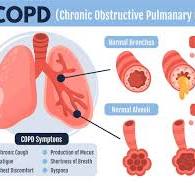Chronic Obstructive Pulmonary Disease (COPD) is a progressive respiratory condition that affects millions worldwide, causing significant morbidity and mortality. Over the years, treatment strategies have evolved, and recent updates in medical guidelines have brought about a paradigm shift in the use of certain medications. Long-Acting Beta-Agonists (LABAs) combined with Inhaled Corticosteroids (ICS) have been a longstanding cornerstone in COPD management. However, emerging evidence and revised recommendations challenge the conventional approach, signaling a reconsideration of this combination therapy.
The Historical Perspective:
The combination of LABAs and ICS was initially embraced for its dual action, targeting both bronchodilation and inflammation in COPD patients. LABAs provide sustained bronchodilation by relaxing smooth muscle in the airways, while ICS suppress inflammation, offering a comprehensive approach to symptom management. This combination was considered particularly beneficial in patients with moderate to severe COPD, aiming to improve lung function, reduce exacerbations, and enhance overall quality of life.
Changing Recommendations:
Recent updates in COPD treatment guidelines, including those from organizations such as the Global Initiative for Chronic Obstructive Lung Disease (GOLD), have brought about a reevaluation of the role of LABAs with ICS in COPD management. Notably, these guidelines now recommend a more personalized and selective approach to treatment, taking into account individual patient characteristics and the potential risks associated with long-term use of ICS.
Risks and Considerations:
While LABAs with ICS have demonstrated efficacy in controlling symptoms and preventing exacerbations, concerns have arisen regarding their long-term use. The potential for side effects such as pneumonia, osteoporosis, and adrenal suppression has prompted a reassessment of the risk-benefit profile, particularly in patients with milder forms of COPD.
Moreover, studies have suggested that a subset of COPD patients may not experience a significant reduction in exacerbations with the addition of ICS, raising questions about the necessity of this combination in all cases. In light of this, guidelines now advocate for a stepwise approach, reserving the use of ICS for patients with specific characteristics, such as a history of frequent exacerbations or eosinophilic inflammation.
The Role of Dual Bronchodilation:
As an alternative, emphasis is now placed on dual bronchodilation, combining long-acting muscarinic antagonists (LAMAs) and LABAs, which has shown efficacy in improving lung function and reducing exacerbations. This approach, supported by a growing body of evidence, provides a targeted strategy without the potential risks associated with prolonged corticosteroid use.
The landscape of COPD management is continually evolving, with a nuanced understanding of the disease and its treatment options. While LABAs with ICS have played a pivotal role in controlling symptoms and preventing exacerbations, recent guidelines highlight the importance of reevaluating their use in light of potential risks and individual patient characteristics. A personalized, evidence-based approach that prioritizes dual bronchodilation without unnecessary corticosteroids is emerging as a cornerstone in the contemporary management of COPD, ensuring optimal outcomes while minimizing potential adverse effects. Patients and healthcare providers alike are encouraged to stay abreast of these evolving recommendations to make informed decisions tailored to individual needs.

